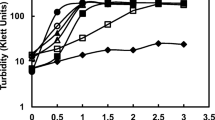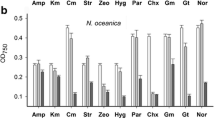Abstract
The effects of several antibiotics on the proliferation of cells of the Closterium peracerosum-strigosum-littorale complex, a unicellular charophycean alga, were examined. When cells were cultured on solid medium containing hygromycin B and phleomycin the proliferation of cells was inhibited at low concentrations of these antibiotics, with a minimum inhibitory concentration of 5.0 and 0.2 µg/mL, respectively. By contrast, kanamycin sulfate was less effective at concentrations up to 50 µg/mL. When cells were incubated in liquid medium containing hygromycin B and phleomycin, cell proliferation was severely inhibited at concentrations of 5.0 and 0.01 µg/mL, respectively. It is concluded that hygromycin B and phleomycin are highly effective for inhibiting the proliferation of C. psl. complex both on solid and in liquid medium and thus are useful for the selection of the cells transformed by selectable marker genes.
Similar content being viewed by others

References
Abe J., Hiwatashi Y., Ito M., Hasebe M. & Sekimoto H. 2008. Expression of exogenous genes under the control of endogenous HSP70 and CAB promoters in the Closterium peracerosumstrigosum-littorale complex. Plant Cell Physiol. 49: 625–632.
Akatsuka S., Tsuchikane Y., Fukumoto R., Fujii T. & Sekimoto H. 2006. Physiological characterization of the sex pheromone protoplast-release-inducing protein from the Closterium peracerosum-strigosum-littorale complex (Charophyta). Phycol. Res. 54: 116–121.
Berthold P., Schmitt R. & Mages W. 2002. An engineered Streptomyces hygroscopicus aph7″ gene mediates dominant resistance against hygromycin B in Chlamydomonas reinhardtii. Protist 153: 401–412.
Davies J. & Wright G.D. 1997. Bacterial resistance to aminoglycoside antibiotics. Trends Microbiol. 5: 234–240.
Gatignol A., Durand H. & Tiraby G. 1988. Bleomycin resistance conferred by a drug-binding protein. FEBS Lett. 230: 171–175.
McCourt R.M., Delwiche C.F. & Karol K.G. 2004. Charophyte algae and land plant origins. Trends Ecol. Evol. 19: 661–666.
Nojiri T., Fujii T. & Sekimoto H. 1995. Purification and characterization of a novel sex pheromone that induces the release of another sex pheromone during sexual reproduction of the heterothallic Closterium peracerosum-strigosum-littorale complex. Plant Cell Physiol. 36: 79–84.
Sekimoto H. 2000. Intercellular communication during sexual reproduction of Closterium (Conjugatophyceae). J. Plant Res. 113: 343–352.
Sekimoto H., Satoh S. & Fujii T. 1990. Biochemical and physiological properties of a protein inducing protoplast release during conjugation in Closterium peracerosum-strigosum-littorale complex. Planta 182: 348–354.
Sekimoto H., Tanabe Y., Takizawa M., Ito N., Fukumoto R. & Ito M. 2003. Expressed sequence tags from the Closterium peracerosum-strigosum-littorale complex, a unicellular charophycean alga, in the sexual reproduction process. DNA Res. 10: 147–153.
Sekimoto H., Tanabe Y., Tsuchikane Y., Shirosaki H., Fukuda H., Demura T. & Ito M. 2006. Gene expression profiling using cDNA microarray analysis of the sexual reproduction stage of the unicellular charophycean alga Closterium peracerosum-strigosum-littorale complex. Plant Physiol. 141: 271–279.
Stevens D.R., Rochaix J.D. & Purton S. 1996. The bacterial phleomycin resistance gene ble as a dominant selectable marker in Chlamydomonas. Mol. Gen. Genet. 251: 23–30.
Tsuchikane Y., Fujii T., Ito M. & Sekimoto H. 2005. A sex pheromone, protoplast release-inducing protein (PR-IP) inducer, induces sexual cell division and production of PR-IP in Closterium. Plant Cell Physiol. 46: 1472–1476.
Veluthambi K., Gupta A.K. & Sharma A. 2003. The current status of plant transformation technologies. Curr. Sci. 84: 368–380.
Author information
Authors and Affiliations
Corresponding author
Rights and permissions
About this article
Cite this article
Abe, J., Sakayori, K. & Sekimoto, H. Effect of antibiotics on cell proliferation in the Closterium peracerosum-strigosum-littorale complex (Charophyceae, Chlorophyta). Biologia 63, 936–940 (2008). https://doi.org/10.2478/s11756-008-0145-5
Received:
Accepted:
Published:
Issue Date:
DOI: https://doi.org/10.2478/s11756-008-0145-5



